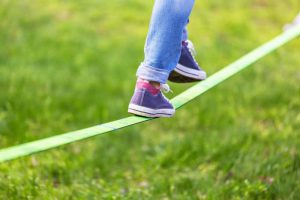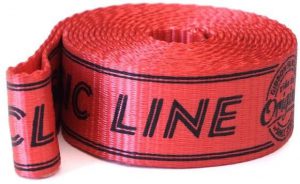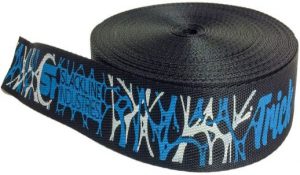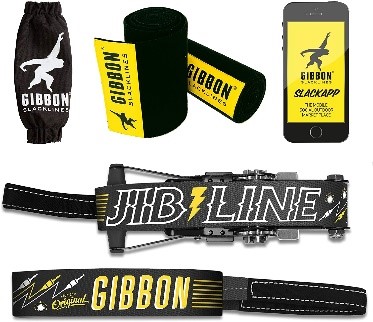
~~~~~~~~~~~~~~~~~~~~~~~~~~~~~~~~~~~~~~~~~~~~~~~~~~~~~~~~~~~~~~~~
“I suppose I’ll have to add the force of gravity to my list of enemies.”
― Lemony Snicket
~~~~~~~~~~~~~~~~~~~~~~~~~~~~~~~~~~~~~~~~~~~~~~~~~~~~~~~~~~~~~~~~
Slacklining is a balance training sport that has several recreational as well as meditative purposes. With a nylon/polyester slackline webbing stretched and tensioned between two anchor points, athletes work on their focus and balance skills to stay upright. The sport has rock climbing origins in the Yosemite National Park communities, from where it evolved into different styles over the years. These adaptations include waterline, highline, trickline, yogaline, and rodeoline activities that improvise the original slackline sport to accommodate stunts.
Modern gear and rigging methods upgrade basic practices of slacklining by improving the overall setup to make it safer for beginners and athletes alike. Social media platforms like Instagram and YouTube allow people to share their experiences and routines, and these have played a major role in the wildfire popularity of slacklining. The youth, in particular, often incorporate slackline tricks into their workout sessions –thanks to the multifaceted nature of slacklining. The fitness and recreational avenues created by this sport provide health and rehab benefits for various audiences, as explored below.
What is slackline webbing?
Synthetic material
Slackline webbing is the synthetic material –usually nylon and polyester –that forms the actual “slackline” for people to walk on, balance, and perform stunts. This material is woven into flat, threaded, or tubular fashions that determine the tensile strength of the webbing. The term “break load” is often used to refer to the applied tension or stress that can cause a webbing to break.
Damages to the webbing
Prolonged use exposes a slackline webbing to damages from the elements, chemicals, and improper setups. These factors lead to abrasive, wear-and-tear destruction that can seriously harm slackliners if the webbing snaps mid-stunt. Repeated use, dirt, and cleaning chemicals are often responsible for shortening the lifespan of webbing materials.
Comparison features
While comparing slackline webbing brands, it helps to keep an eye out for certain features. These include the breaking strength, material weight, stretching potential, webbing dimensions, and weave patterns. Not only do these features contribute to the longevity and user-friendliness of slackline assembling, but they also help to choose the right type of webbing that supports stunts through added flexibility.
Slackline governing bodies
ISA and Slackline US
Organizations like the International Slackline Association (ISA) and Slackline US aim to empower slackline communities. Their standards and protocols focus on safety and environmental aspects such as webbing specifications, backup accessories, and tree protection – since the two anchor points are mostly trees.
Approved andtested safety logo
The ISA is a grassroots initiative that is driven by slacklining communities around the world. Collaborations from American, Swiss, Austrian, and German organizations launched the ISA program that governs slacklining practices to promote athlete safety and sustainability. For example, the ISA safety label on slacklining equipment indicates authorized testing and approval by ISA standards, making these webbings and accessories excellent choices for slackliners. Various brands like Balance Community and Slacktivity sell webbing products that are ISA-approved and have the safety logo.
Leave No Trace ethics
Slackline US is a member of the ISA. It offers access management, rigging resources, clean-up projects, and Leave No Trace ethics to promote environmentally-friendly slacklining practices. These outdoor ethics of Leave No Trace (LNT) guidelines focus on conservation principles to minimize the recreational footprint on the environment. Slackliners are expected to leave the natural monuments, plants, and wildlife untouched, unharmed, and unaltered. Only appropriate sites and trees that are suitable for slacklining activities should be explored. Waste management and disposal are imperative, and slackliners need to stick to established trails for avoiding widespread damage.
Slackline webbing brands
GIBBON Slacklines
GIBBON Slacklines simplifies the setup and management aspects of slacklining, allowing it to be a sport for everyone. The brand is famous for its slackline catalog that includes purpose-built equipment such as webbing materials. The GIBBON application helps to bridge any learning gaps through tutorials. By using the GIBBON SlackApp, beginners can optimize their experiences on the slackline through safety tips and efficient assembling/dismantling techniques. The app’s SlackSpot option is a unique way to find slackline parks nearby.
SLACKRACK CLASSIC YELLOW WEBBING and SLACKRACK CLASSICRED WEBBING are compatible with GIBBON Slackracks. These classic webbings are made of polyester and have a break load of 40 kilonewtons, which refers to the applied tension that can break the webbing. They are 4.5 m long and 5 cm wide. With these replacement webbing options, you can make your GIBBON Slackrack appear as good as new.
SLACKRACK FITNESS WEBBING is also available to add versatility to your gym workouts. It can be improvised into different uses with GIBBON Slackracks. The polyester webbing measures 4.5 m x 5 cm and has a break load of 20 kilonewtons.
Balance Community
Balance Community has a diverse assortment of slackline kits, gear, and webbing. The retail company specializes in slacklining products and follows green working ethics to minimize its consumer footprint. This includes using recycled shipping boxes, recycled mail, as well as recycled receipts throughout the logistics and delivery stages.
An interactive tension calculator on the website allows you to choose slackline length, sag, and body weight to display approximations as well as exact tension values. The online tool is a great way to compare tensions across highlines, tricklines, rodeolines, etc. for choosing the right type of webbing for individual pursuits.
The Balance Community catalog has several options for webbing styles. These range from lightweight polyester and stretchy nylon to anchor and tubular webbings. Each product is accompanied by its own comprehensive webbing specifications and design highlights. Some of the key descriptions include strength and dimension values, weave structure, and sleeve properties. This helps in guiding your perusals so that you focus on essentials like abrasion resistance or UV protection, apart from bouncing flexibility to support stunts
Slackline Industries
Slackline Industries is another leading brand that stole the spotlight for its innovative, environmentally-responsible outlook. Its products address the needs of first-time slackliners as well as professionals. These products are developed to fulfill the applications of the vast slackline spectrum, so there is something to purchase for every athlete. All Slackline Industries gear and accessories are simple, functional, and tested for quality assurance.
The virtual shop displays several slacklining essentials, including webbing options. The Trickline Webbing, for instance, is a performance slackline webbing that brings your jumping, spinning, and rotation skills on the line. It is approved by safety regulations to facilitate tricklining maneuvers through the trampoline effect, reinforced by rubber grips for safety.
Slackline Industries’ Boss Line Webbing is a competition style trickline for high-performance tricks. Its trampoline-style weave has rubber gripping to support heavy-duty training on the line. Both kinds of webbing from the brand are fully-adjustable and have a webbing strength of29.89 KN.
Slackline webbings for your digital cart
Gibbon Slacklines Classic Webbing for Slackrack Classic or Fintess, red, Length 4,5m, Width 50mm/2″, Replacement Webbing

Gibbon Slacklines’ red slackline webbing is equipped with a reinforced loop and is compatible across Gibbon Slackracks. It has a flat webbing pattern that is ideal for the trampoline effect during slacklining jumps, bounces, and stunts. The polyester material is designed to enhance your slackline’s orientation which is further improved by the ergonomic ratchet for superior tensioning
Slackline Industries Trick Line -Webbing Only

Slackline Industries webbing is compatible with 2-inch double-ratchet systems. It is designed to create extra bounce that imitates the trampoline effect – which is just what is needed for tricklining stunts. The webbing is best-suited for advanced rigging contexts that require slackliners or trickliners to first configure the right tension before executing their stunts. It is available in a portable mesh bag for simple storage and transport.
Gibbon Slacklines Jibline with treewear, Black, 49ft (41ft line + 8ft Ratchet Strap with Reinforced Loop) incl. Ratchet Protection, treewear (Black Felt), line Width 50mm/2

Gibbon Slacklines’ Jibline kit includes the slackline with loops, a ratchet system, a support manual, and Velcro tree wear. Its flat webbing is designed for the trampoline effect on all slackline maneuvers. This polyester webbing has a continuous print backed with ergonomic supports to ease assembling and dismantling. The jibline set is specifically-built for basic moves like drop knee and chest bounce. Jibline mostly focuses on feet-to-feet tricks on high-quality webbing that dips and rises with the added force.
Discover your balance in life
Slacklining thinks outside the sports box by taking rehab routes to provide effective solutions in overcoming physical challenges. The art of slacklining stimulates your neuromuscular system when you work on focus, balance, and response. This trains your muscle memory to “remember” the movements as reflexes that put your coordination skills to the test.
Various training regimens make use of slacklining for orthopedic reasons like physiotherapies that help people coax their stiff muscles and bones back into motion. Slackline therapy is often employed by sports brands like GIBBON Slacklines to bridge motor gaps arising from damaged joints or ligaments. These in-house sessions cater to stability issues among the injured, the elderly, and the physically-challenged.
Through regular slackline training, people develop better equilibrium for independent balancing and coordination – both on the slackline and the floor. It is a holistic therapy option that targets impaired neurological responses as well as limited motor skills. During these slackline pursuits, people achieve balance by learning how to choreograph their movements with the best slacklining teacher – gravity.
